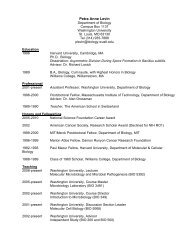Guide for doing FRAP with Leica TCS SP2 - Biocenter
Guide for doing FRAP with Leica TCS SP2 - Biocenter
Guide for doing FRAP with Leica TCS SP2 - Biocenter
Create successful ePaper yourself
Turn your PDF publications into a flip-book with our unique Google optimized e-Paper software.
<strong>FRAP</strong>Figure 5 (raw, Pre) shows a prebleach image of amouse fibroblast nucleus transfected <strong>with</strong> histone H1fused to GFP <strong>with</strong> bleach ROI (green), whole cell ROI(red) and the unbleached part of the cell (orange)overlaid. Figure 5 also shows the first postbleach(Post1) and the last image (Post3) of a <strong>FRAP</strong> series<strong>with</strong> the same cell.Data processingAs mentioned above the values <strong>for</strong> the characteristicrelaxation time τ, the recovery half-time t 1/2 and therecovery rate are only rough estimates, because thedata has not been corrected. There are three necessarycorrections: Background subtraction, correction<strong>for</strong> (unintended) photobleaching during acquisition ofpost-bleach images and finally normalization (Figure 2).All three will be explained in the following.Figure 3 illustrates the meaning and positions of thedifferent regions of interest (ROIs) used. For clarityROIs are not drawn to scale and the bleach ROI isdepicted in red, but will be depicted in green <strong>with</strong> actualdata (see below).Background subtractionAll images contain a background signal. Some of it isdue to noise of the photomultiplier tubes (PMTs) andthe electronics, some is background fluorescencedue to residual staining or overexpression or mislocationof the GFP-tagged protein. The <strong>for</strong>mer kind ofbackground originates from the hardware and canonly be reduced by setting a lower PMT voltage at theexpense of sensitivity. It can be treated by recordingan image <strong>with</strong> all lasers turned off and the respectivePMT turned on. This “noise image” can later on besubtracted from the image series.Note: Make sure that there are no pixels <strong>with</strong> zerointensity. You can check <strong>for</strong> zero values <strong>with</strong> the“O/U LUT (glow over/under)” (they are green). If thereare zero values increase the offset of the PMT. Thehistogram can also help to find the backgroundvalue. The simulation software by Siggia et al. (2000)uses the histogram peak near the low end of thehistogram <strong>for</strong> background subtraction.If the image contains parts of a cell which is not stainedin the respective channel, background due tofluorescence can be corrected <strong>for</strong> by subtracting theaveraged intensity of unstained parts from the <strong>FRAP</strong>series. In the example Figure 5 (upper row, right) theaveraged intensity of ROI 4 (cyan) would be subtracted.Figure 2Necessary corrections represented schematically. Raw data givenin dark red (dots), after background subtraction (red dash-dots) andcorrection <strong>for</strong> photobleaching artifacts (solid blue). Note the intensitydecrease after time 100 caused by photobleaching during acquisition.After normalization relative fluorescence values are plotted over time(right figure, solid black line).Correct <strong>for</strong> fluorescence lossdue to photobleachingWe have to distinguish two kinds of photobleaching:Firstly, the intended photobleach <strong>with</strong> full laser intensityduring the bleach pulse, secondly, photobleachingduring post-bleach acquisition. While the <strong>for</strong>merphotobleaching is intended, the latter is inherent tothe imaging process and can lead to some considerableloss of total fluorescence. There<strong>for</strong>e, the fluorescenceintensity can never recover to 100%, even if allfluorophore molecules were mobile (see “Calculationof mobile fraction”). It is possible to correct <strong>for</strong> thisamount of photobleaching by multiplying every element6Confocal Application Letter











